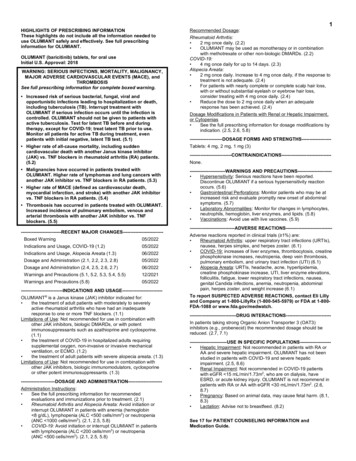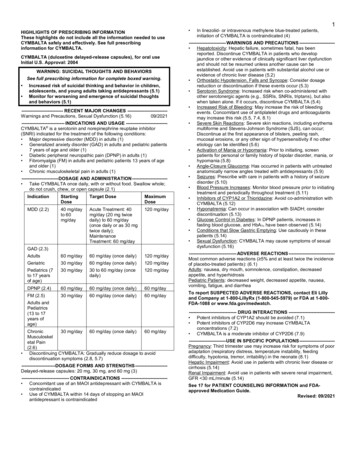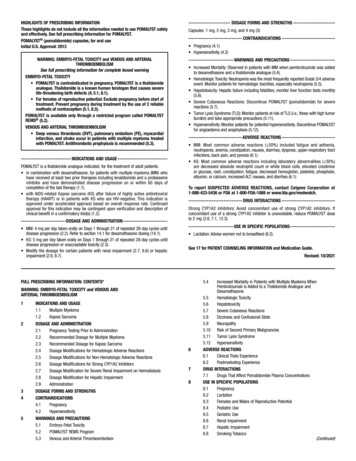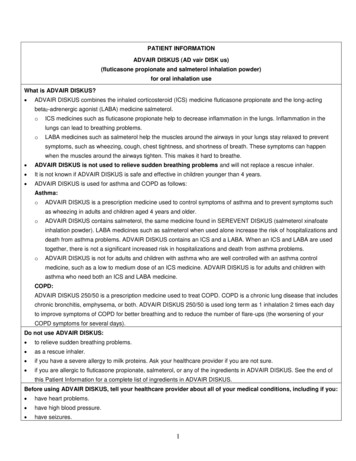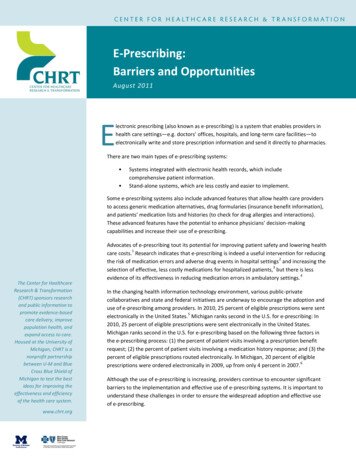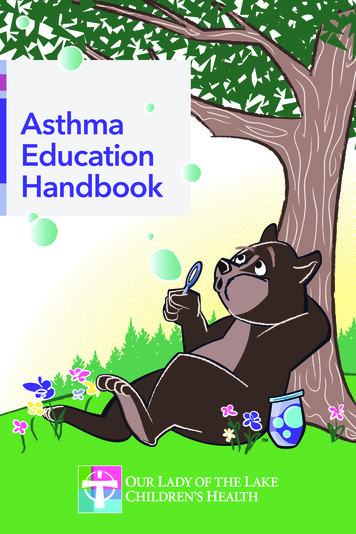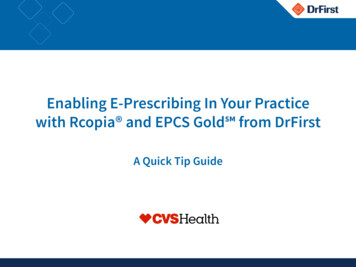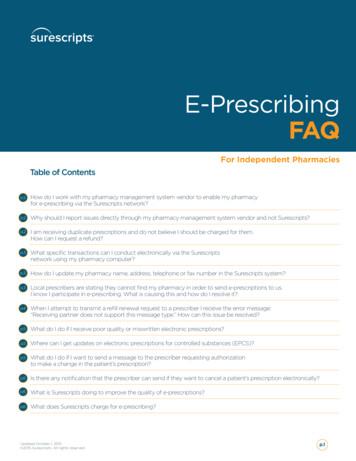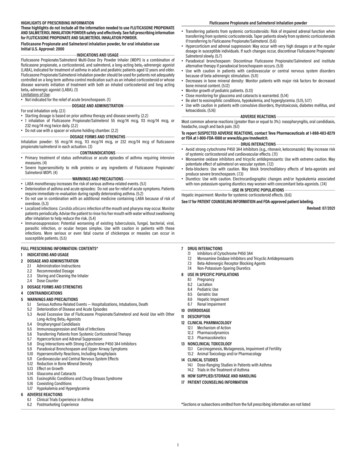
Transcription
HIGHLIGHTS OF PRESCRIBING INFORMATIONThese highlights do not include all the information needed to use FLUTICASONE PROPIONATEAND SALMETEROL INHALATION POWDER safely and effectively. See full prescribing informationfor FLUTICASONE PROPIONATE AND SALMETEROL INHALATION POWDER.Fluticasone Propionate and Salmeterol inhalation powder, for oral inhalation useInitial U.S. Approval: 2000INDICATIONS AND USAGEFluticasone Propionate/Salmeterol Multi-Dose Dry Powder Inhaler (MDPI) is a combination offluticasone propionate, a corticosteroid, and salmeterol, a long-acting beta2-adrenergic agonist(LABA), indicated for treatment of asthma in adult and pediatric patients aged 12 years and older.Fluticasone Propionate/Salmeterol inhalation powder should be used for patients not adequatelycontrolled on a long term asthma control medication such as an inhaled corticosteroid or whosedisease warrants initiation of treatment with both an inhaled corticosteroid and long actingbeta2-adrenergic agonist (LABA). (1)Limitations of Use: Not indicated for the relief of acute bronchospasm. (1)DOSAGE AND ADMINISTRATIONFor oral inhalation only. (2.1) Starting dosage is based on prior asthma therapy and disease severity. (2.2) 1 inhalation of Fluticasone Propionate/Salmeterol 55 mcg/14 mcg, 113 mcg/14 mcg, or232 mcg/14 mcg twice daily. (2.2) Do not use with a spacer or volume holding chamber. (2.2)DOSAGE FORMS AND STRENGTHSInhalation powder: 55 mcg/14 mcg, 113 mcg/14 mcg, or 232 mcg/14 mcg of fluticasonepropionate/salmeterol in each actuation. (3)CONTRAINDICATIONS Primary treatment of status asthmaticus or acute episodes of asthma requiring intensivemeasures. (4) Severe hypersensitivity to milk proteins or any ingredients of Fluticasone Propionate/Salmeterol MDPI. (4)WARNINGS AND PRECAUTIONS LABA monotherapy increases the risk of serious asthma-related events. (5.1) Deterioration of asthma and acute episodes: Do not use for relief of acute symptoms. Patientsrequire immediate re-evaluation during rapidly deteriorating asthma. (5.2) Do not use in combination with an additional medicine containing LABA because of risk ofoverdose. (5.3) Localized infections: Candida albicans infection of the mouth and pharynx may occur. Monitorpatients periodically. Advise the patient to rinse his/her mouth with water without swallowingafter inhalation to help reduce the risk. (5.4) Immunosuppression: Potential worsening of existing tuberculosis, fungal, bacterial, viral,parasitic infection, or ocular herpes simplex. Use with caution in patients with theseinfections. More serious or even fatal course of chickenpox or measles can occur insusceptible patients. (5.5)Fluticasone Propionate and Salmeterol inhalation powder Transferring patients from systemic corticosteroids: Risk of impaired adrenal function whentransferring from systemic corticosteroids. Taper patients slowly from systemic corticosteroidsif transferring to Fluticasone Propionate/Salmeterol. (5.6) Hypercorticism and adrenal suppression: May occur with very high dosages or at the regulardosage in susceptible individuals. If such changes occur, discontinue Fluticasone Propionate/Salmeterol slowly. (5.7) Paradoxical bronchospasm: Discontinue Fluticasone Propionate/Salmeterol and institutealternative therapy if paradoxical bronchospasm occurs. (5.9) Use with caution in patients with cardiovascular or central nervous system disordersbecause of beta adrenergic stimulation. (5.11) Decreases in bone mineral density: Monitor patients with major risk factors for decreasedbone mineral content. (5.12) Monitor growth of pediatric patients. (5.13) Close monitoring for glaucoma and cataracts is warranted. (5.14) Be alert to eosinophilic conditions, hypokalemia, and hyperglycemia. (5.15, 5.17) Use with caution in patients with convulsive disorders, thyrotoxicosis, diabetes mellitus, andketoacidosis. (5.16)ADVERSE REACTIONSMost common adverse reactions (greater than or equal to 3%): nasopharyngitis, oral candidiasis,headache, cough and back pain. (6.1)To report SUSPECTED ADVERSE REACTIONS, contact Teva Pharmaceuticals at 1-888-483-8279or FDA at 1-800-FDA-1088 or www.fda.gov/medwatch.DRUG INTERACTIONS Avoid strong cytochrome P450 3A4 inhibitors (e.g., ritonavir, ketoconazole): May increase riskof systemic corticosteroid and cardiovascular effects. (7.1) Monoamine oxidase inhibitors and tricyclic antidepressants: Use with extreme caution. Maypotentiate effect of salmeterol on vascular system. (7.2) Beta-blockers: Use with caution. May block bronchodilatory effects of beta-agonists andproduce severe bronchospasm. (7.3) Diuretics: Use with caution. Electrocardiographic changes and/or hypokalemia associatedwith non-potassium-sparing diuretics may worsen with concomitant beta-agonists. (7.4)USE IN SPECIFIC POPULATIONSHepatic impairment: Monitor for systemic corticosteroid effects. (8.6)See 17 for PATIENT COUNSELING INFORMATION and FDA-approved patient labeling.Revised: 07/20217 DRUG INTERACTIONS7.1 Inhibitors of Cytochrome P450 3A47.2 Monoamine Oxidase Inhibitors and Tricyclic Antidepressants7.3 Beta-Adrenergic Receptor Blocking Agents7.4 Non-Potassium-Sparing Diuretics8 USE IN SPECIFIC POPULATIONS8.1 Pregnancy8.2 Lactation8.4 Pediatric Use8.5 Geriatric Use8.6 Hepatic Impairment8.7 Renal Impairment10 OVERDOSAGE11 DESCRIPTION12 CLINICAL PHARMACOLOGY12.1 Mechanism of Action12.2 Pharmacodynamics12.3 Pharmacokinetics13 NONCLINICAL TOXICOLOGY13.1 Carcinogenesis, Mutagenesis, Impairment of Fertility13.2 Animal Toxicology and/or Pharmacology14 CLINICAL STUDIES14.1 Dose-Ranging Studies in Patients with Asthma14.2 Trials in the Treatment of Asthma16 HOW SUPPLIED/STORAGE AND HANDLING17 PATIENT COUNSELING INFORMATIONFULL PRESCRIBING INFORMATION: CONTENTS*1 INDICATIONS AND USAGE2 DOSAGE AND ADMINISTRATION2.1 Administration Instructions2.2 Recommended Dosage2.3 Storing and Cleaning the Inhaler2.4 Dose Counter3 DOSAGE FORMS AND STRENGTHS4 CONTRAINDICATIONS5 WARNINGS AND PRECAUTIONS5.1 Serious Asthma-Related Events — Hospitalizations, Intubations, Death5.2 Deterioration of Disease and Acute Episodes5.3 Avoid Excessive Use of Fluticasone Propionate/Salmeterol and Avoid Use with OtherLong-Acting Beta2-Agonists5.4 Oropharyngeal Candidiasis5.5 Immunosuppression and Risk of Infections5.6 Transferring Patients from Systemic Corticosteroid Therapy5.7 Hypercorticism and Adrenal Suppression5.8 Drug Interactions with Strong Cytochrome P450 3A4 Inhibitors5.9 Paradoxical Bronchospasm and Upper Airway Symptoms5.10 Hypersensitivity Reactions, Including Anaphylaxis5.11 Cardiovascular and Central Nervous System Effects5.12 Reduction in Bone Mineral Density5.13 Effect on Growth5.14 Glaucoma and Cataracts5.15 Eosinophilic Conditions and Churg-Strauss Syndrome5.16 Coexisting Conditions5.17 Hypokalemia and Hyperglycemia6 ADVERSE REACTIONS6.1 Clinical Trials Experience in Asthma6.2 Postmarketing Experience*Sections or subsections omitted from the full prescribing information are not listed1
Fluticasone Propionate and Salmeterol inhalation powderFluticasone Propionate and Salmeterol inhalation powderFULL PRESCRIBING INFORMATION1INDICATIONS AND USAGEFluticasone Propionate/Salmeterol Multidose Dry Powder Inhaler (FS MDPI) is indicated forthe treatment of asthma in adult and pediatric patients aged 12 years and older. FluticasonePropionate/Salmeterol MDPI should be used for patients not adequately controlled on a longterm asthma control medication such as an inhaled corticosteroid or whose disease warrantsinitiation of treatment with both an inhaled corticosteroid and long acting beta2-adrenergicagonist (LABA).Limitations of Use:Fluticasone Propionate/Salmeterol MDPI is not indicated for the relief of acute bronchospasm.2DOSAGE AND ADMINISTRATION2.1Administration Instructions Fluticasone Propionate/Salmeterol MDPI is for oral inhalation and does not require priming. Do not use Fluticasone Propionate/Salmeterol MDPI with a spacer or volume holdingchamber. Do not use more than two times every 24 hours. More frequent administration or a greaternumber of daily inhalations (more than one inhalation twice daily) is not recommendedas some patients are more likely to experience adverse reactions with higher salmeteroldosages. Avoid the concomitant use of other long acting beta2-adrenergic agonist (LABAs) [seeWarnings and Precautions (5.3, 5.11)]. If asthma symptoms arise in the period between doses, an inhaled, short-acting beta2agonist should be taken for immediate relief.2.2Recommended DosageAdminister 1 inhalation of Fluticasone Propionate/Salmeterol MDPI twice daily by oral inhalation(approximately 12 hours apart at the same time every day). Rinse the mouth with water withoutswallowing after each inhalation.Dosage SelectionThe recommended starting dosage for Fluticasone Propionate/Salmeterol MDPI is based onasthma severity and current inhaled corticosteroid use and strength. Patients not taking inhaled corticosteroids (ICS) (with less severe asthma):o 1 inhalation of 55 mcg/14 mcg Fluticasone Propionate/Salmeterol MDPI dosestrength (55 mcg of fluticasone propionate and 14 mcg of salmeterol), twice daily byoral inhalation. Patients with greater asthma severity, use the higher dose strengths:o 1 inhalation of 113 mcg/14 mcg Fluticasone Propionate/Salmeterol MDPI (113 mcg offluticasone propionate and 14 mcg of salmeterol) twice daily; oro 1 inhalation of 232 mcg/14 mcg Fluticasone Propionate/Salmeterol MDPI (232 mcg offluticasone propionate and 14 mcg of salmeterol) twice daily Patients switching to Fluticasone Propionate/Salmeterol MDPI from another inhaledcorticosteroid or combination product:o 1 inhalation of low (55 mcg/14 mcg), medium (113 mcg/14 mcg) or high (232 mcg/14 mcg) Fluticasone Propionate/Salmeterol MDPI twice daily by oral inhalationbased on the strength of the previous inhaled corticosteroid product, or thestrength of the inhaled corticosteroid from a combination product, and diseaseseverity. The maximum recommended dosage of Fluticasone Propionate/Salmeterol MDPI is232 mcg/14 mcg twice daily.General Dosing InformationImprovement in asthma control following Fluticasone Propionate/Salmeterol MDPI administrationcan occur within 15 minutes of beginning treatment; although maximum benefit may not beachieved for 1 week or longer after starting treatment. Individual patients will experience avariable time to onset and degree of symptom relief. For patients who do not respond adequatelyto the starting dose of Fluticasone Propionate/Salmeterol MDPI after 2 weeks of therapy, considerincreasing the strength (replace with higher strength) to possibly provide additional improvementin asthma control.If a previously effective dosage regimen fails to provide adequate improvement in asthma control,re-evaluate the therapeutic regimen, including patient compliance and inhaler technique, andconsider additional therapeutic options (e.g., increasing the dose of Fluticasone Propionate/Salmeterol MDPI with a higher strength, adding additional controller therapies). After asthmastability has been achieved, it is desirable to titrate to the lowest effective dosage to reduce therisk of adverse reactions.2.3Storing and Cleaning the Inhaler Keep the inhaler in a cool dry place. Routine maintenance is not required. If the mouthpiece needs cleaning, gently wipe themouthpiece with a dry cloth or tissue as needed. Never wash or put any part of the inhaler in water.2.4Dose CounterThe Fluticasone Propionate/Salmeterol MDPI has a dose counter: The number 60 is displayed (prior to use). The dose counter will count down each time the mouthpiece is opened and closed [seePatient Counseling Information (17)].3DOSAGE FORMS AND STRENGTHSInhalation powder: an inhalation-driven, multidose, dry powder inhaler (MDPI) for oral inhalationthat meters 55 mcg, 113 mcg, or 232 mcg of fluticasone propionate with 14 mcg of salmeterol fromthe device reservoir and delivers 49 mcg, 100 mcg, or 202 mcg of fluticasone propionate with12.75 mcg of salmeterol, respectively, from the mouthpiece per actuation. The FluticasonePropionate/Salmeterol MDPI is a white inhaler with a yellow cap, and is provided in a sealed foilpouch with desiccant [see How Supplied/Storage and Handling (16)].4CONTRAINDICATIONSFluticasone Propionate/Salmeterol MDPI is contraindicated in: the primary treatment of status asthmaticus or other acute episodes of asthma whereintensive measures are required [see Warnings and Precautions (5.2)]. patients with known severe hypersensitivity to milk proteins or who have demonstratedhypersensitivity to fluticasone propionate or any of the excipients [see Warnings andPrecautions (5.10) and Description (11)].5WARNINGS AND PRECAUTIONS5.1Serious Asthma-Related Events — Hospitalizations, Intubations, DeathUse of LABA as monotherapy [without inhaled corticosteroids (ICS)] for asthma is associated with anincreased risk of asthma-related death [see Salmeterol Multicenter Asthma Research Trial (SMART)].Available data from controlled clinical trials also suggest that use of LABA as monotherapy increasesthe risk of asthma-related hospitalization in pediatric and adolescent patients. These findings areconsidered a class effect of LABA monotherapy. When LABA are used in fixed-dose combinationwith ICS, data from large clinical trials do not show a significant increase in the risk of seriousasthma-related events (hospitalizations, intubations, death) compared with ICS alone [see SeriousAsthma-Related Events with Inhaled Corticosteroid/Long-acting Beta2-adrenergic Agonists].Serious Asthma-Related Events with Inhaled Corticosteroid/Long-acting Beta2-adrenergic AgonistsFour large, 26-week, randomized, blinded, active-controlled clinical safety trials were conductedto evaluate the risk of serious asthma-related events when LABA were used in fixed-dosecombination with ICS compared with ICS alone in subjects with asthma. Three (3) trials includedadult and adolescent subjects aged 12 years and older: 1 trial compared budesonide/formoterol tobudesonide, 1 trial compared fluticasone propionate/salmeterol inhalation powder to fluticasonepropionate inhalation powder, and 1 trial compared mometasone furoate/formoterol to mometasonefuroate. The fourth trial included pediatric subjects aged 4 to 11 years and compared fluticasonepropionate/salmeterol inhalation powder to fluticasone propionate inhalation powder. The primarysafety endpoint for all 4 trials was serious asthma-related events (hospitalizations, intubations,death). A blinded adjudication committee determined whether events were asthma-related.The 3 adult and adolescent trials were designed to rule out a risk margin of 2.0, and the pediatrictrial was designed to rule out a risk margin of 2.7. Each individual trial met its pre-specified objectiveand demonstrated non-inferiority of ICS/LABA to ICS alone. A meta-analysis of the 3 adult andadolescent trials did not show a significant increase in risk of a serious asthma-related eventwith ICS/LABA fixed-dose combination compared with ICS alone (Table 1). These trials were notdesigned to rule out all risk for serious asthma-related events with ICS/LABA compared with ICS.Table 1. Meta-analysis of Serious Asthma-Related Events in Subjects with Asthma Aged12 Years and OlderICS/LABA vs. ICSHazard RatioICS/LABAICS(95% CI)b(n 17,537)a(n 17,552)aSerious asthma-related eventc1161051.10 (0.85, 1.44)Asthma-related death20Asthma-related intubation12(endotracheal)Asthma-related hospitalization115105( 24-hour stay)ICS Inhaled Corticosteroid; LABA Long-acting Beta2-adrenergic Agonist.aRandomized subjects who had taken at least 1 dose of study drug. Planned treatment used foranalysis.bEstimated using a Cox proportional hazards model for time to first event with baseline hazardsstratified by each of the 3 trials.cNumber of subjects with events that occurred within 6 months after the first use of studydrug or 7 days after the last date of study drug, whichever date was later. Subjects can haveone or more events, but only the first event was counted for analysis. A single, blinded,independent adjudication committee determined whether events were asthma related.The pediatric safety trial included 6,208 pediatric patients aged 4 to 11 years who received ICS/LABA (fluticasone propionate/salmeterol inhalation powder) or ICS (fluticasone propionateinhalation powder). In this trial 27/3,107 (0.9%) of patients treated with ICS/LABA and 21/3,101(0.7%) of patients treated with ICS experienced a serious asthma-related event. There were noasthma-related deaths or intubations. ICS/LABA did not show a significantly increased risk of aserious asthma-related event compared to ICS based on the prespecified risk margin (2.7), withan estimated hazard ratio of time to first event of 1.29 (95% CI: 0.73, 2.27).Salmeterol Multicenter Asthma Research Trial (SMART)A 28-week, placebo-controlled, U.S. trial that compared the safety of salmeterol with placebo,each added to usual asthma therapy, showed an increase in asthma-related deaths in subjectsreceiving salmeterol (13/13,176 in subjects treated with salmeterol versus 3/13,179 in subjectstreated with placebo; relative risk: 4.37 [95% CI: 1.25, 15.34]). Use of background ICS was notrequired in SMART. The increased risk of asthma-related death is considered a class effect ofLABA monotherapy.5.2Deterioration of Disease and Acute EpisodesFluticasone Propionate/Salmeterol MDPI should not be initiated in patients during rapidlydeteriorating or potentially life-threatening episodes of asthma. Fluticasone Propionate/Salmeterol MDPI has not been studied in subjects with acutely deteriorating asthma. Theinitiation of Fluticasone Propionate/Salmeterol MDPI in this setting is not appropriate.Serious acute respiratory events, including fatalities, have been reported when salmeterol, acomponent of this product, has been initiated in patients with significantly worsening or acutelydeteriorating asthma. In most cases, these have occurred in patients with severe asthma (e.g.,patients with a history of corticosteroid dependence, low pulmonary function, intubation,mechanical ventilation, frequent hospitalizations, previous life-threatening acute asthmaexacerbations) and in some patients with acutely deteriorating asthma (e.g., patients withsignificantly increasing symptoms; increasing need for inhaled, short-acting beta2-agonists;2
Fluticasone Propionate and Salmeterol inhalation powderFluticasone Propionate and Salmeterol inhalation powderdecreasing response to usual medications; increasing need for systemic corticosteroids; recentemergency room visits; deteriorating lung function). However, these events have occurred in afew patients with less severe asthma as well. It was not possible from these reports to determinewhether salmeterol contributed to these events.Increasing use of inhaled, short-acting beta2-agonists is a marker of deteriorating asthma. Inthis situation, the patient requires immediate reevaluation with reassessment of the treatmentregimen, giving special consideration to the possible need for replacing the current strengthof Fluticasone Propionate/Salmeterol MDPI with a higher strength, adding additional inhaledcorticosteroid, or initiating systemic corticosteroids. Patients should not use more than 1inhalation twice daily of Fluticasone Propionate/Salmeterol MDPI.Fluticasone Propionate/Salmeterol MDPI should not be used for the relief of acute symptoms, i.e.,as rescue therapy for the treatment of acute episodes of bronchospasm. An inhaled, short-actingbeta2-agonist, not Fluticasone Propionate/Salmeterol MDPI, should be used to relieve acutesymptoms such as shortness of breath. When prescribing Fluticasone Propionate/SalmeterolMDPI, the healthcare provider should also prescribe an inhaled, short-acting beta2-agonist(e.g., albuterol) for treatment of acute symptoms, despite regular twice-daily use of FluticasonePropionate/Salmeterol MDPI.When beginning treatment with Fluticasone Propionate/Salmeterol MDPI, patients who havebeen taking oral or inhaled, short-acting beta2-agonists on a regular basis (e.g., 4 times a day)should be instructed to discontinue the regular use of these drugs.5.3Avoid Excessive Use of Fluticasone Propionate/Salmeterol and Avoid Use withOther Long-Acting Beta2-AgonistsFluticasone Propionate/Salmeterol MDPI should not be used more often than recommended, athigher doses than recommended, or in conjunction with other medicines containing LABA, as anoverdose may result. Clinically significant cardiovascular effects and fatalities have been reportedin association with excessive use of inhaled sympathomimetic drugs. Patients using FluticasonePropionate/Salmeterol MDPI should not use another medicine containing a LABA (e.g., salmeterol,formoterol fumarate, arformoterol tartrate, indacaterol) for any reason.5.4Oropharyngeal CandidiasisIn clinical trials, the development of localized infections of the mouth and pharynx with Candidaalbicans has occurred in subjects treated with Fluticasone Propionate/Salmeterol MDPI. When suchan infection develops, it should be treated with appropriate local or systemic (i.e., oral) antifungaltherapy while treatment with Fluticasone Propionate/Salmeterol MDPI continues, but at timestherapy with Fluticasone Propionate/Salmeterol MDPI may need to be interrupted. Advise thepatient to rinse his/her mouth with water without swallowing following inhalation to help reducethe risk of oropharyngeal candidiasis.5.5Immunosuppression and Risk of InfectionsPersons who are using drugs that suppress the immune system are more susceptible to infectionsthan healthy individuals. Chickenpox and measles, for example, can have a more serious or evenfatal course in susceptible adolescents or adults using corticosteroids. In such patients whohave not had these diseases or who have not been properly immunized, particular care should betaken to avoid exposure. How the dose, route and duration of corticosteroid administration affectthe risk of developing a disseminated infection is not known. The contribution of the underlyingdisease and/or prior corticosteroid treatment to the risk is also not known. If a patient is exposedto chickenpox, prophylaxis with varicella-zoster immune globulin (VZIG) or pooled intravenousimmunoglobulin (IVIG) may be indicated. If a patient is exposed to measles, prophylaxis withpooled intramuscular immunoglobulin (IG) may be indicated. (See the respective packageinserts for complete VZIG and IG prescribing information.) If chickenpox develops, treatment withantiviral agents may be considered.Inhaled corticosteroids should be used with caution, if at all, in patients with active or quiescenttuberculosis infections of the respiratory tract; systemic fungal, bacterial, viral, or parasiticinfections; or ocular herpes simplex.5.6Transferring Patients from Systemic Corticosteroid TherapyHPA Suppression/Adrenal InsufficiencyParticular care is needed for patients who are transferred from systemically active corticosteroidsto inhaled corticosteroids because deaths due to adrenal insufficiency have occurred in patientswith asthma during and after transfer from systemic corticosteroids to less systemically availableinhaled corticosteroids. After withdrawal from systemic corticosteroids, a number of months arerequired for recovery of hypothalamic-pituitary-adrenal (HPA) function.Patients who have been previously maintained on 20 mg or more of prednisone (or its equivalent)may be most susceptible, particularly when their systemic corticosteroids have been almostcompletely withdrawn. During this period of HPA suppression, patients may exhibit signs andsymptoms of adrenal insufficiency when exposed to trauma, surgery, or infection (particularlygastroenteritis) or other conditions associated with severe electrolyte loss. Although FluticasonePropionate/Salmeterol MDPI may improve control of asthma symptoms during these episodes,in recommended doses it supplies less than normal physiological amounts of corticosteroidsystemically and does NOT provide the mineralocorticoid activity that is necessary for copingwith these emergencies.During periods of stress or a severe asthmatic attack, patients who have been withdrawn fromsystemic corticosteroids should be instructed to resume oral corticosteroids (in large doses)immediately and to contact their physician for further instruction. These patients should alsobe instructed to carry a medical identification warning card indicating that they may needsupplementary systemic corticosteroids during periods of stress or a severe asthma attack.Patients requiring systemic corticosteroids should be weaned slowly from systemic corticosteroiduse after transferring to Fluticasone Propionate/Salmeterol MDPI. Lung function (mean forcedexpiratory volume in 1 second [FEV1] or morning peak expiratory flow [AM PEF]), beta-agonist use, andasthma symptoms should be carefully monitored during withdrawal of systemic corticosteroids.In addition to monitoring asthma signs and symptoms, patients should be observed for signs andsymptoms of adrenal insufficiency, such as fatigue, lassitude, weakness, nausea and vomiting,and hypotension.Unmasking of Allergic Conditions Previously Suppressed by Systemic CorticosteroidsTransfer of patients from systemic corticosteroid therapy to Fluticasone Propionate/SalmeterolMDPI may unmask allergic conditions previously suppressed by the systemic corticosteroidtherapy (e.g., rhinitis, conjunctivitis, eczema, arthritis, eosinophilic conditions).Corticosteroid Withdrawal SymptomsDuring withdrawal from oral corticosteroids, some patients may experience symptoms ofsystemically active corticosteroid withdrawal (e.g., joint and/or muscular pain, lassitude,depression) despite maintenance or even improvement of respiratory function.5.7Hypercorticism and Adrenal SuppressionFluticasone propionate, a component of Fluticasone Propionate/Salmeterol MDPI, will often helpcontrol asthma symptoms with less suppression of HPA function than therapeutically equivalentoral doses of prednisone. Since fluticasone propionate is absorbed into the circulation and can besystemically active at higher doses, the beneficial effects of Fluticasone Propionate/SalmeterolMDPI in minimizing HPA dysfunction may be expected only when recommended dosages arenot exceeded and individual patients are titrated to the lowest effective dose. A relationshipbetween plasma levels of fluticasone propionate and inhibitory effects on stimulated cortisolproduction has been shown after 4 weeks of treatment with fluticasone propionate inhalationaerosol. Since individual sensitivity to effects on cortisol production exists, physicians shouldconsider this information when prescribing Fluticasone Propionate/Salmeterol MDPI.Because of the possibility of significant systemic absorption of inhaled corticosteroids, patientstreated with Fluticasone Propionate/Salmeterol MDPI should be observed carefully for anyevidence of systemic corticosteroid effects. Particular care should be taken in observing patientspostoperatively or during periods of stress for evidence of inadequate adrenal response.It is possible that systemic corticosteroid effects such as hypercorticism and adrenalsuppression (including adrenal crisis) may appear in a small number of patients who aresensitive to these effects. If such effects occur, Fluticasone Propionate/Salmeterol MDPI shouldbe reduced slowly, consistent with accepted procedures for reducing systemic corticosteroids,and for management of asthma symptoms.5.8Drug Interactions with Strong Cytochrome P450 3A4 InhibitorsThe use of strong cytochrome P450 3A4 (CYP3A4) inhibitors (e.g., ritonavir, atazanavir,clarithromycin, indinavir, itraconazole, nefazodone, nelfinavir, saquinavir, ketoconazole,telithromycin) with Fluticasone Propionate/Salmeterol MDPI is not recommended becauseincreased systemic corticosteroid and increased cardiovascular adverse effects may occur [seeDrug Interactions (7.1) and Clinical Pharmacology (12.3)].5.9Paradoxical Bronchospasm and Upper Airway SymptomsAs with other inhaled medicines, Fluticasone Propionate/Salmeterol MDPI can produce paradoxicalbronchospasm, which may be life-threatening. If paradoxical bronchospasm occurs followingdosing with inhaled fluticasone propionate/salmeterol medicines, it should be treated immediatelywith an inhaled, short-acting bronchodilator; inhaled fluticasone propionate/salmeterol medicinesshould be discontinued immediately; and alternative therapy should be instituted. Upper airwaysymptoms of laryngeal spasm, irritation, or swelling, such as stridor and choking, have beenreported in patients receiving inhaled fluticasone propionate/salmeterol medicines.5.10Hypersensitivity Reactions, Including AnaphylaxisImmediate hypersensitivity reactions (e.g., urticaria, angioedema, rash, bronchospasm,hypotension), including anaphylaxis, may occur after administration of Fluticasone Propionate/Salmeterol MDPI. There have been reports of anaphylactic reactions in patients with severe milkprotein allergy after inhalation of other powder products containing lactose; therefore, patientswith severe milk protein allergy should not use Fluticasone Propionate/Salmeterol MDPI [seeContraindications (4)].5.11Cardiovascular and Central Nervous System EffectsExcessive beta-adrenergic stimulation has been associated with seizures, angina, hypertensionor hypotension, tachycardia with rates up to 200 beats/min, arrhythmias, nervousness, headache,tremor, palpitation, nausea, dizziness, fatigue, malaise, and insomnia [see Overdosage ]. Therefore,Fluticasone Propionate/Salmeterol MDPI, like all products containing sympathomimetic amines,should be used with caution in patients with cardiovascular disorders, especially coronaryinsufficiency, cardiac arrhythmias, and hypertension.Salmeterol, a component of Fluticasone Propionate/Salmeterol MDPI, can produce a clinicallysignificant cardiovascular ef
12.1 Mechanism of Action 12.2 Pharmacodynamics 12.3 Pharmacokinetics 13 NONCLINICAL TOXICOLOGY 13.1 Carcinogenesis, Mutagenesis, Impairment of Fertility 13.2 Animal Toxicology and/or Pharmacology 14 CLINICAL STUDIES 14.1 Dose-Ranging Studies in Patients with Asthma 14.2 Trials in the Treatment of Asthma 16 HOW SUPPLIED/STORAGE AND HANDLING

